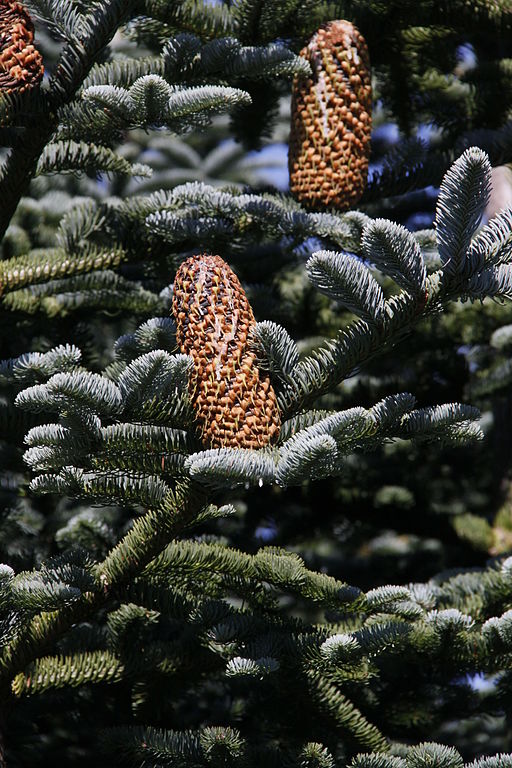Timberpedia - Noble Fir
Noble Fir
| Latin Name: | Irish Name: | Native to Ireland? |
|---|---|---|
| Abies procera or nobilis | No |
About the Tree
Introduced 1831 to 1833.
The Noble fir’s silvery blue young foliage contrasts with older greener needles Popular as a
Christmas tree, especially as it holds its colour and it doesn’t shed it’s needles. It is frost sensitive
and is very hard to grow on the continent. However, it grows well on suitable soils in Ireland, from
where they are exported in large numbers to the continent where the trees achieve a premium
price over other species of Christmas tree such a Norway Spruce and Nordman.
Mature trees produce a long, clear bole with a dome like crown. With a deep and spreading rootsystem, this species prefers a deep, cool and moist soil. Growth in height and diameter is slow during seedling stage but is moderately rapid in later years. Heights of 90 to 120 feet are reported of trees at ages of 100 to 120 years. Maturity is reached in about 350 years.
Abies procera is a fir from western North America that became popular in Britain and Ireland mostly
as a garden ornamental. It grows to its full height in the mountains.
The Noble fir grows to between 30metres and 50metres in height and up to 9 metres in width.
About the Wood
Timber may be (unfairly) regarded a being of inferior quality. Now mostly grown for Christmas tree
production and foliage.
Due to its high strength to weight ratio, it was previously used in the making venetian blinds,
veneers and was also used for ladder rails and airplane construction.
Wood – light, hard, strong, close grained, works easily
Know your wood! The Timberpedia is a broad resource that aims to catalogue all the major tree species in Ireland, containing information that we’ve gathered from over two decades maintaining our natural woodland and serving Ireland’s woodworking industry.
All written material is copyright © 2021 by the Lisnavagh Timber Project.
Timberpedia
- Acacia
- Alder (Common)
- Apple
- Apple (Crab)
- Apple (Japanese Crab)
- Ash
- Aspen (Trembling Poplar)
- Beech
- Beech (Copper)
- Beech (Southern)
- Birch
- Box
- Cedar (Western Red)
- Cedar of Lebanon
- Cherry (Bird)
- Cherry (Wild) / Gean
- Chestnut (Horse)
- Chestnut (Sweet / Spanish)
- Cypress (Lawson)
- Cypress (Monterey)
- Elm (English)
- Elm (Wych)
- Eucalyptus
- Fir (Douglas)
- Fir (Grand/Giant)
- Fir (Noble)
- Fir (Silver/European)
- Hawthorn
- Hazel
- Holly
- Hornbeam
- Ivy
- Laburnum
- Larch (European)
- Larch (Japanese)
- Larch (Red)
- Laurel
- Lime
- Maidenhair Tree
- Maple (Field)
- Maple (Norway)
- Mimosa / Silver Wattle
- Monkey-Puzzle
- Musk (Olearia)
- Oak (Cork)
- Oak (Holm / Holly / Evergreen)
- Oak (Pedunculate / English)
- Oak (Red)
- Oak (Sessile / Irish)
- Oak (Turkey)
- Pear
- Pine
- Pine (Scots)
- Plane (London / Lacewood)
- Poplar (Black Cottonwood / Western Balsam)
- Poplar (Grey)
- Rowan (Mountain Ash)
- Spruce (Norway)
- Spruce (Sitka)
- Sycamore
- Tulip Tree
- Walnut (Black)
- Walnut (Common)
- Wellingtonia
- Western Hemlock
- Whitebeam
- Wild Service Tree
- Willow
- Willow (Bay)
- Willow (Crack)
- Willow (Cricket Bat)
- Willow (Goat / Sallow)
- Willow (White / Silver)
- Yew (English)
- Yew (Irish)




